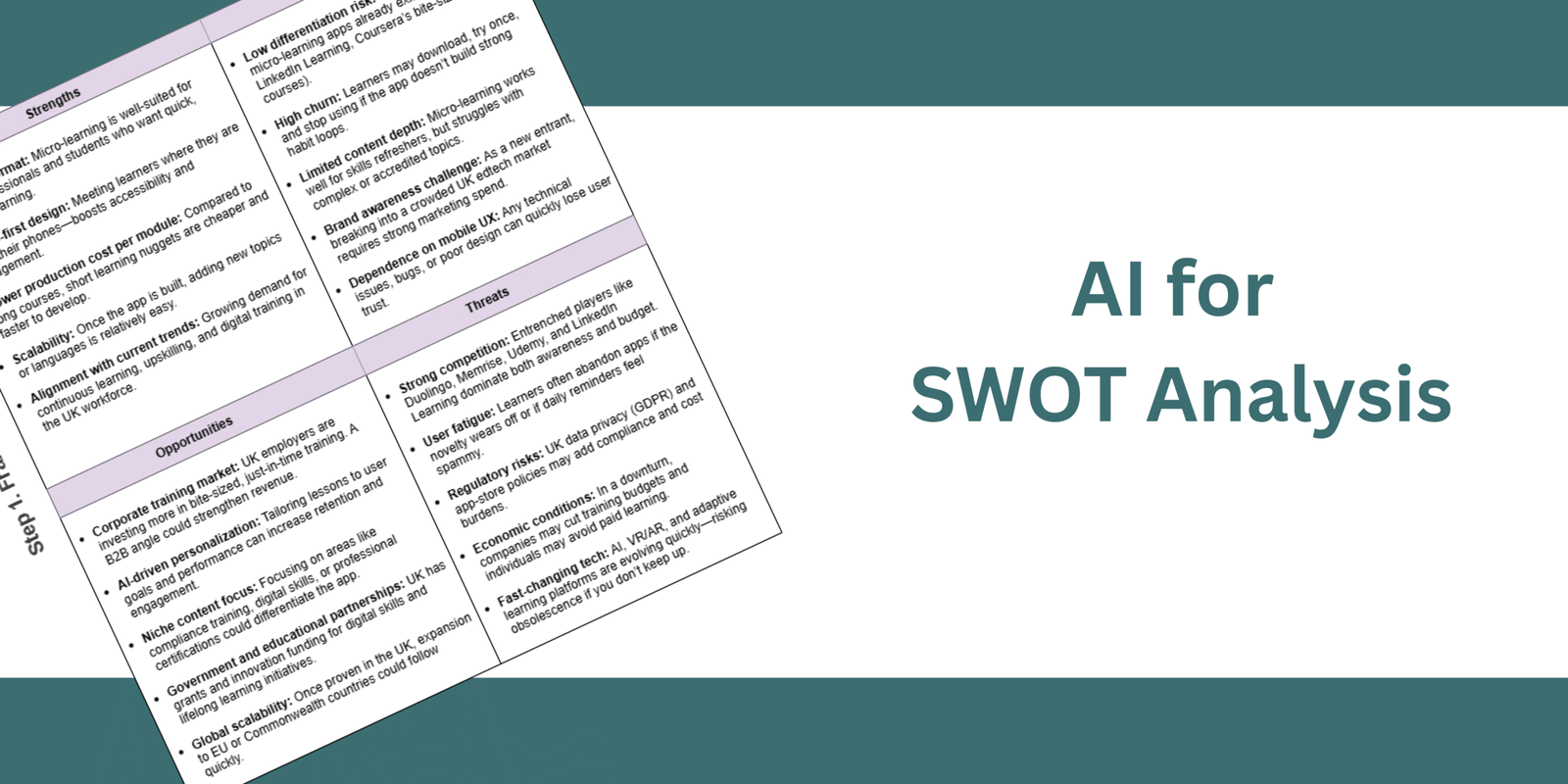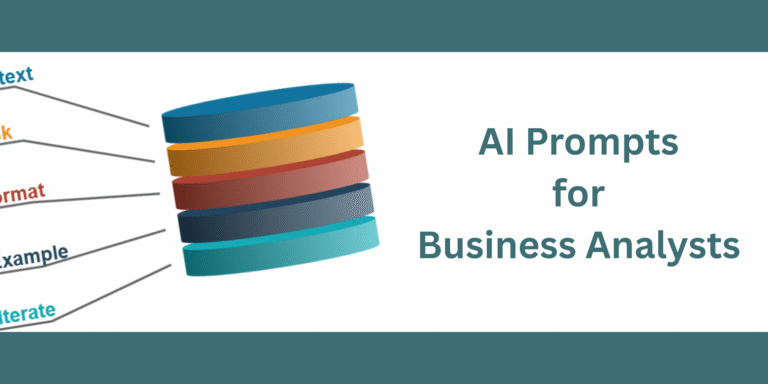AI for SWOT Analysis: Step-by-Step Walkthrough
If you’re tired of blank pages and slow brainstorms, using AI for SWOT analysis can be your secret accelerator.
With the right prompts, AI helps you brainstorm strengths, weaknesses, opportunities, and threats faster, prioritize what matters, and turn insights into action, without losing your strategic edge. Below is a practical, SEO-friendly walkthrough you can copy, paste, and use on your next project.
Acknowledgement
Keep in mind that the responses you get can vary significantly based on the chatbot you’re using and your previous conversations with it. For the test below, I am using ChatGPT-5.
For easier scanning, I’ve provided the AI output in grid view (see images after each step).
What is SWOT (and why add AI)?
A SWOT analysis organizes Strengths, Weaknesses, Opportunities, and Threats into a simple 2×2 grid.
- Strengths & Weaknesses = internal factors
- Opportunities & Threats = external factors
Where AI shines is speed and structure. It can synthesize notes, expand ideas you’ve missed, and format outputs (tables, bullets, summaries) in seconds. All this while you stay in the driver’s seat. AI just does the heavy lifting.
Before you start: scope, inputs, guardrails
- Define the scope. What are you analyzing and why? (e.g., “Launch an edtech mobile app in the UK.”)
- Collect quick inputs. Brief business context, target segments, a few metrics (conversion rate, churn rate, NPS), and 3 to 5 competitors.
- Guardrails. It is highly important not to paste sensitive data in public tools. Ask AI to separate assumptions vs facts you provided.
Helpful tools you will need
A chat AI (like ChatGPT or Copilot), a spreadsheet for scoring, and your BA toolkit (PESTLE, Porter’s Five Forces) for context.
The scenario we’ll use
To make this concrete, we’ll walk through an EdTech platform launching a mobile micro-learning app in the UK. You can swap this context with your own project.
Step-by-step: AI for SWOT Analysis
1) Frame the objective with a first draft
Prompt
You are a business analyst. Help me run a SWOT for an edtech company launching a mobile micro-learning app in the UK within 12 months. The goal is to assess viability and key risks. Keep language plain and business-friendly.
What you’ll get
A crisp setup and a list of straight-forward SWOT points. In some cases, the chatbot may request additional info such as segments, price point, competitors. If so, provide short and to-the-point answers.
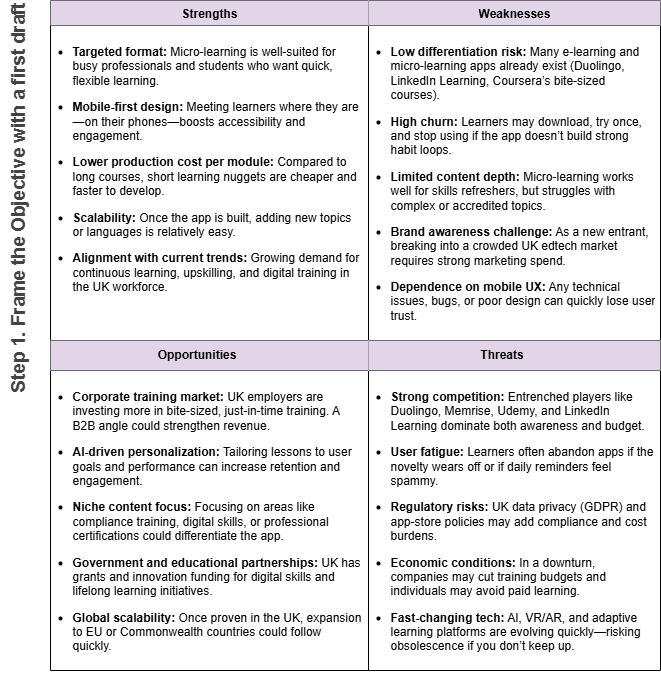
2) Add some context (PESTLE + competitors)
Prompt
Think step by step. First draft a brief PESTLE for UK edtech (3 bullets per factor). Then list the top 5 competitor types we should consider.
What you’ll get
A bulleted list for each PESTLE point targeted to your market, as well as a list of competitors you need to monitor more closely
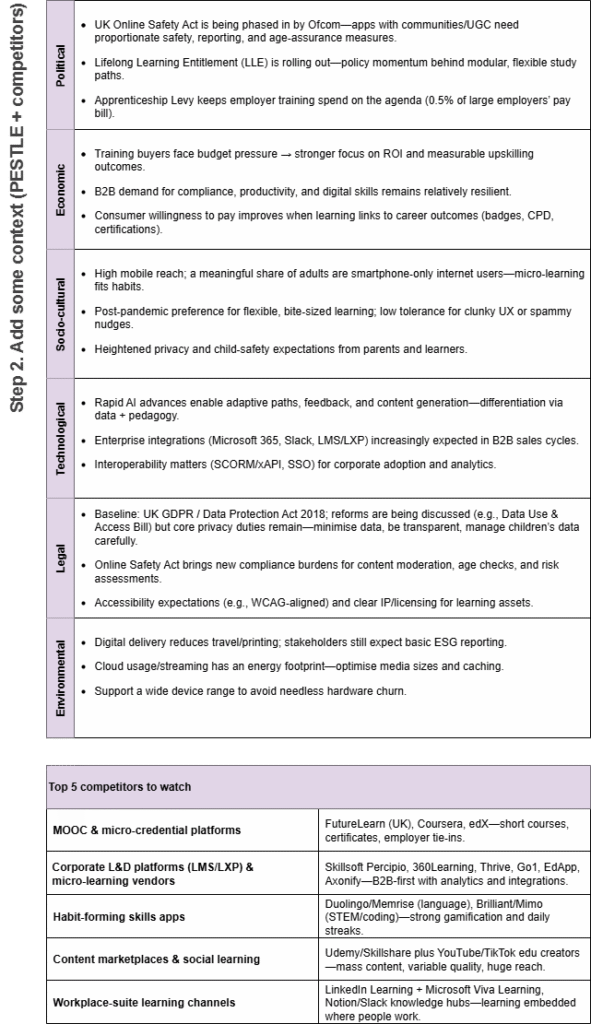
3) Validate with Data (and make AI ask for it)
Prompt
List the 8 most important facts you need to validate the SWOT and make it specific and testable (e.g., CAC, churn, ARPU, procurement cycles). Mark each as “provided/not provided.
What you’ll get
A grid with all the data necessary to create a meaningful analysis on the current project.
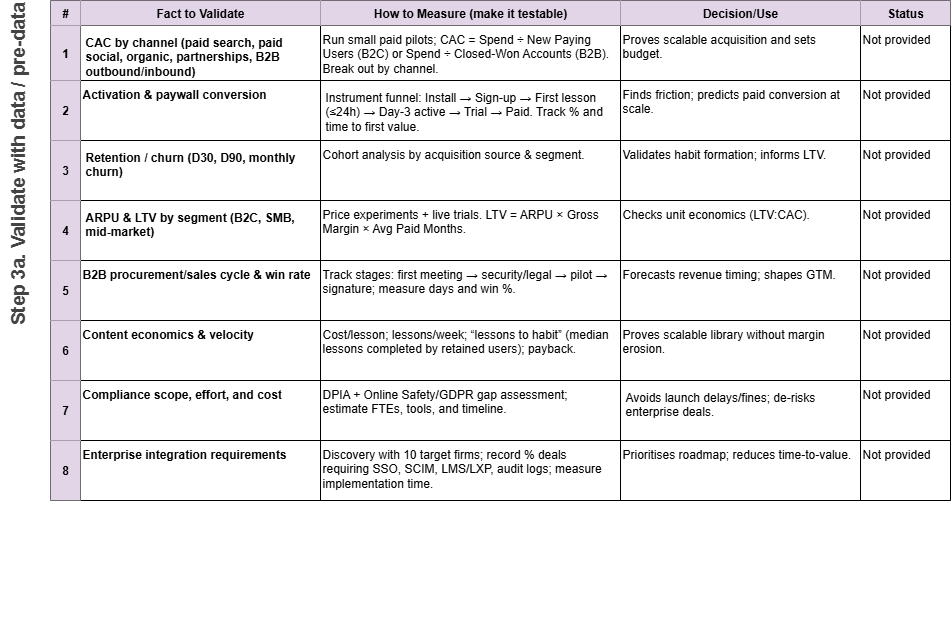
Once you know what’s needed, provide the numbers (even directional). For the sake of the test scenario, I asked for suitable sample data.
Prompt
Update the SWOT using the metrics below. Keep each bullet specific and testable.
1. B2C: Paid search £35–£70; Paid social £45–£90; Influencer/affiliates £20–£40; Content/SEO blended ≤£15. B2B: Inbound £800–£2,500/closed-won; Outbound £2k–£6k/closed-won.
2. Install→Sign-up 40–60%; Sign-up→First lesson ≤24h 60–80%; D3 active (of installers) 20–35%; Trial start 8–15% (of installers) or 15–25% (of sign-ups); Paid 3–6% (of installers) or 20–35% (of trials); Median time-to-first-lesson <3 min.
3. D30 retained actives (of installers) 15–25%; D90 8–15%. Paid churn/month: B2C 5–9%; B2B seat churn/month 0.3–0.8% (≈4–10% annual)
4. B2C: Net ARPU £6–£9/mo; Avg paid months 5–8; Gross margin 80–85% ⇒ LTV £30–£61. B2B/seat: ARPU £5–£10/mo; Avg term 18–30 mo; GM 85% ⇒ LTV/seat £77–£255
5. SMB: 30–60 days, win 20–30%. Mid-market: 60–120 days, win 12–20%. Enterprise: 120–240 days, win 5–12%.
6. Cost/lesson: £200–£500 (2–5 min micro-lesson incl. SME/QA). Velocity: 25–40 lessons/week (core team + freelancers). Lessons-to-habit: 6–10. Content payback: <4 months on top 20% of lessons.
7. One-off project: 8–12 weeks; 2–3 Eng FTE + 0.2 Legal FTE; £60k–£120k total. Recurring: moderation/age-assurance/tools £2k–£6k/mo; age checks £0.10–£0.50 per verification.
8. Must-haves by deal type: SSO in 80% mid-market/95% enterprise; SCIM 50%/70%; LMS/LXP connectors 60%/75%; audit logs 60–80%. Time-to-implement: 3–10 days per customer.
Now your SWOT is anchored in reality, not vibes.
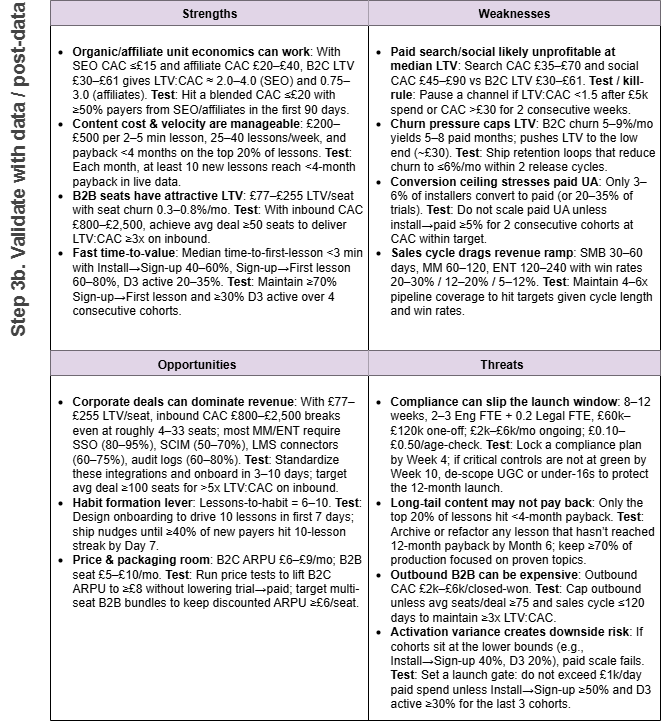
4) Prioritize with impact/control scoring
Furthermore, AI can help you move from a wall of bullets to clear priorities.
Prompt
Score each SWOT item for Business Impact (1–5) and Level of Control (1–5). Return a table sorted by Impact desc, then Control desc. Recommend the top 5 items to act on first.
What you’ll get
An ordered grid with points that have highest impact and most control on organisation side.
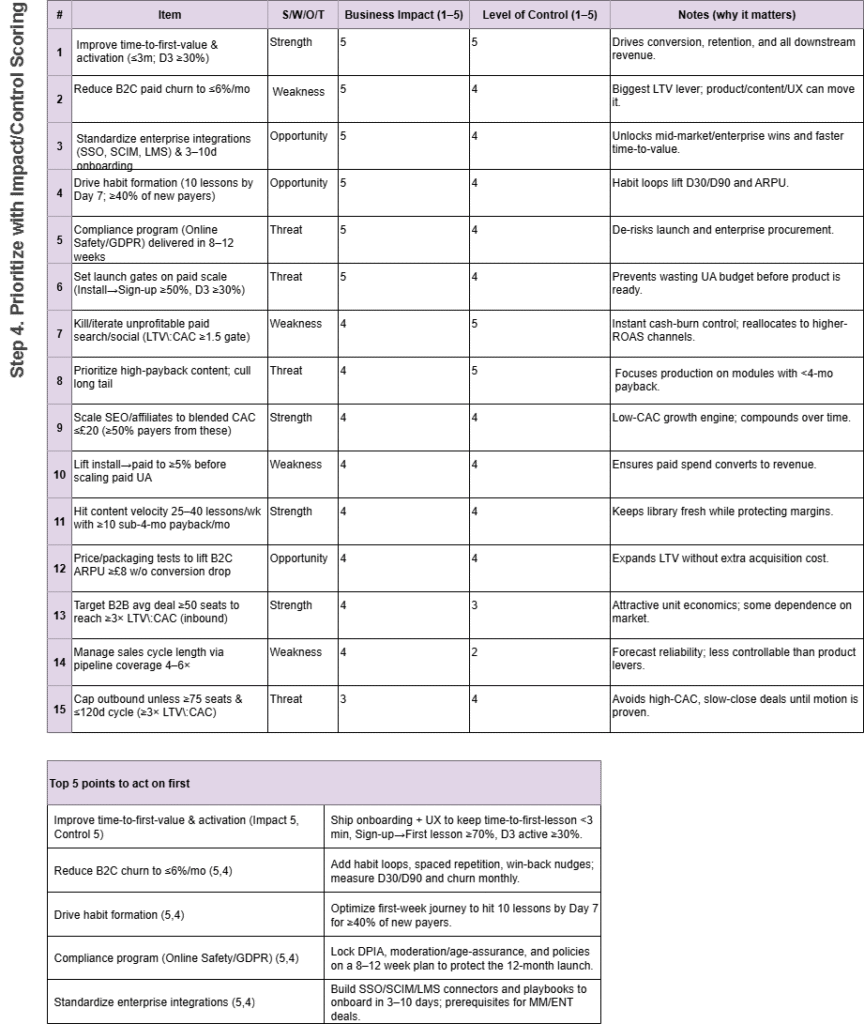
5) Turn SWOT into strategy (TOWS mapping)
Prompt
Map top Strengths to Opportunities (SO), Weaknesses to Opportunities (WO), Strengths to Threats (ST), and Weaknesses to Threats (WT). Return 2–3 strategies per cell, each with a one-line KPI.
What you’ll get
A TOWS mapping based on all available details
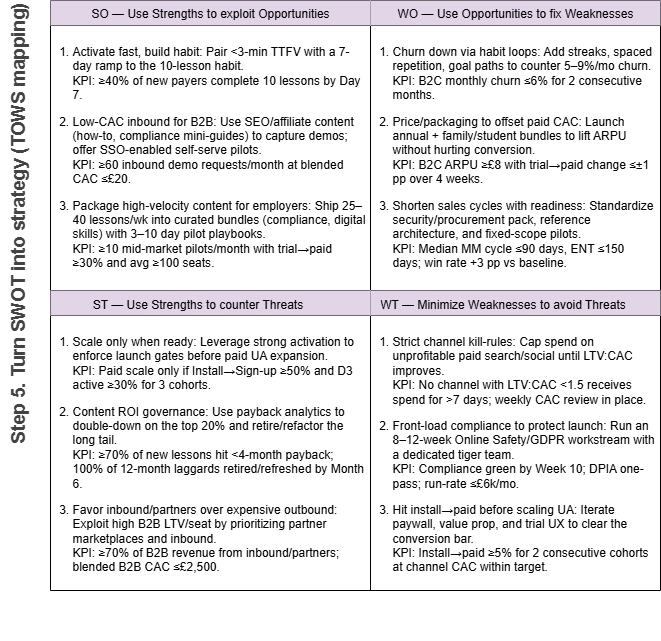
6) Create an action plan (owners, dates, budget)
Prompt
Convert the top five strategies into an action plan. Add owner, start/end dates, dependencies, and a rough budget band (S/M/L).
What you’ll get
A list of the top strategies defined earlier with the requested details.
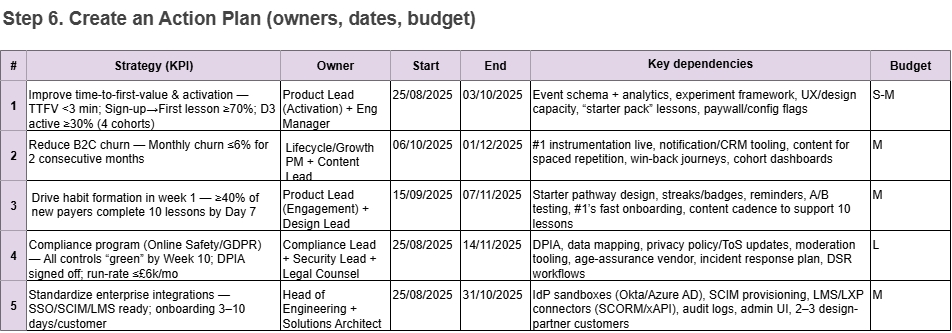
7) Executive summary for stakeholders
Prompt
Write a 150-word executive summary of the SWOT, highlighting 3 decisive actions and expected impact in the next 2 quarters. Avoid jargon.
What you’ll get
A ready-made summary as a result for using AI for SWOT analysis that you can paste into your deck or one-pager.
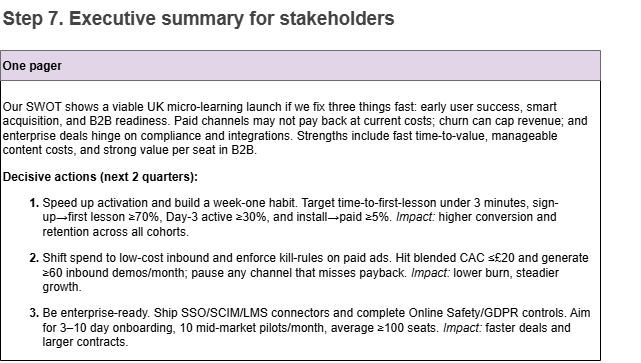
Bonus: Prompt Patterns That Work
To consistently get high-quality outputs, structure prompts like a BA requirement:
- Role + Context. “Act as a business analyst… context is…”
- Task. “Produce a 2×2 SWOT with specific, testable bullets.”
- Format. “Return as a markdown table and keep each bullet <15 words.”
- Constraints. “Separate assumptions from facts I provided. Flag data gaps.”
- Iterate. Ask for scoring, prioritization, then TOWS strategies, then action plan.
Chain-of-thought style (without overdoing it)
Think step by step. First note assumptions vs facts. Then draft SWOT. Then propose 5 actions with KPIs.
This way you’ll get clearer reasoning trails you can challenge or refine.
Common Mistakes (and AI fixes)
- Vague bullets → “Be specific and testable; add metrics or examples.”
- One-and-done SWOT → “Propose a quarterly refresh and owner list.”
- Ideas with no action → “Map TOWS and produce a resourced action plan.”
- No prioritization → “Score impact/control and sort descending.”
FAQs
Is AI replacing BA judgment?
No. It speeds up brainstorming and formatting. You still need to validate, prioritize, and decide.
Can I do this for personal/career SWOTs?
Absolutely. Swap the context and keep the same flow (it’s great for role changes).
What about accuracy?
You can ask AI to label assumptions and request sources. Use your data to calibrate outputs. And always, always! verify data before handing it further.
Wrap-Up
Using AI for swot analysis turns a classic framework into a fast, iterative, and evidence-friendly workflow. You provide context and judgment, while AI provides speed, structure, and neatly formatted outputs – SWOT, priorities, TOWS strategies, and action plans. All in minutes. Try the prompts above on your next initiative and watch the time-to-insight shrink.

